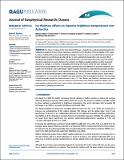Por favor, use este identificador para citar o enlazar a este item:
http://hdl.handle.net/10261/116548COMPARTIR / EXPORTAR:
 SHARE SHARE
 CORE
BASE CORE
BASE
|
|
| Visualizar otros formatos: MARC | Dublin Core | RDF | ORE | MODS | METS | DIDL | DATACITE | |

| Título: | Ice thickness effects on Aquarius brightness temperatures over Antarctica |
Autor: | Pablos, Miriam CSIC ORCID ; Piles, María CSIC ORCID; González Gambau, Verónica ; Camps, Adriano CSIC ORCID; Vall-llossera, Mercè | Fecha de publicación: | abr-2015 | Editor: | American Geophysical Union | Citación: | Journal of Geophysical Research-Oceans 120(4): 2856-2868 (2015) | Resumen: | The Dome-C region, in the East Antarctic Plateau, is regarded as an ideal natural laboratory for calibration/validation of space-borne microwave radiometers. At L-band, the thermal stability of this region has been confirmed by several experimental campaigns. However, its use as an independent external calibration target has recently been questioned due to some spatial inhomogeneities and seasonal effects revealed in the brightness temperatures (TB) acquired in this area. This paper shows the observed relationship, from exploratory research, between the Antarctic ice thickness spatial variations and the measured Aquarius TB changes. A 3-months no-daylight period during the Austral winter has been analyzed. Four transects have been defined over East Antarctica covering areas with different ice thickness variations and ranges. The theoretical L-band penetration depth has been estimated to understand the possible contributions to the measured signal. A good agreement has been observed between Aquarius TB and ice thickness variations over the whole Antarctica, with correlations of ∼0.6-0.7. The two variables show a linear trend with slopes of ∼8.3-9.5 K/km. No correlation has been observed with the subglacial bedrock. The maximum L-band penetration depth has been estimated to be ∼1-1.5 km. Results are therefore consistent: the spatial variations found on Aquarius TB are not related to the emissivity of the bedrock, which lies deeper. This study provides evidence that new L-band satellite observations could contribute to further our understanding of Antarctic geophysical processes. Key Points: Relationship between Antarctic ice thickness and observed Aquarius TB. Maximum L-band penetration depth over Antarctic ice.Possible influence of subglacial lakes on Aquarius TB © 2015. American Geophysical Union. All Rights Reserved | Descripción: | 13 pages, 7 figures, 1 table, the Aquarius L2 V3.0 data are available at oceandata.sci.gsfc.nasa.gov/Aquarius/V3/V3.0/L2, the Antarctic data sets from the Bedpmap2 project are available at https://secure.antarctica.ac.uk/data/bedmap2/, the subglacial lakes inventory is available at https://doi.org/10.1017/S095410201200048X | Versión del editor: | https://doi.org/10.1002/2014JC010151 | URI: | http://hdl.handle.net/10261/116548 | DOI: | 10.1002/2014JC010151 | Identificadores: | e-issn: 2169-9291 |
| Aparece en las colecciones: | (ICM) Artículos |
Ficheros en este ítem:
| Fichero | Descripción | Tamaño | Formato | |
|---|---|---|---|---|
| Pablos_et_al_2015.pdf | 1,95 MB | Adobe PDF |  Visualizar/Abrir |
CORE Recommender
SCOPUSTM
Citations
7
checked on 17-abr-2024
WEB OF SCIENCETM
Citations
7
checked on 21-feb-2024
Page view(s)
319
checked on 18-abr-2024
Download(s)
231
checked on 18-abr-2024
Google ScholarTM
Check
Altmetric
Altmetric
NOTA: Los ítems de Digital.CSIC están protegidos por copyright, con todos los derechos reservados, a menos que se indique lo contrario.
